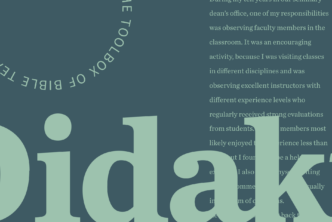Sue Edwards | Dallas Theological Seminary
How you view women influences how you teach them. Paul uses familial language to describe Christian relationships, and I’ve found this imagery useful in creating a healthy classroom ethos where both women and men thrive.
Do not rebuke an older man harshly, but exhort him as if he were your father. Treat younger men as brothers, older women as mothers, and younger women as sisters, with absolute purity. (1 Tim 5:1 NIV)
Particularly for women without healthy family experiences, God can use a professor’s influence for titanic good or ill. Below are some tendencies I’ve found helpful, gleaned from many decades of teaching women.
1. Many women underestimate their abilities and value.
In discussing how female students approach learning, Deborah Stipek paints two caricatures representing the extremes: “Hopeless Hannah” and “Safe Sally.” “Hopeless Hannah” views herself as incompetent, with a “why try” attitude.1 Stipek labels her as a classic example of “learned helplessness,” an attitude some women pursue, fearing if they are too smart they won’t attract men. “Safe Sally” makes straight A’s, meticulously follows directions, and is well-behaved and highly motivated—as long as the learning requires no risk of failure. Learning is something you do in school that brings no joy, and the desire to become a lifelong learner will be abandoned upon graduating. If “Hopeless Hannah” or “Safe Sally” sit in your classroom, you’ll need to help them overcome obvious hindrances.
Certainly not all women fit these descriptions, but as a professor often I observe women who do. In various ways they underestimate their abilities, while many of my male students tend to overestimate theirs. If a woman does poorly on an exam, she can be quick to label herself “stupid.” If she does well, I hear her tell a friend the test was “easy.” On the other hand, if a male student does well, he easily puffs up with pride: “Whoop, I am so smart!” And if he does badly, I’m not surprised to hear him blame the test or me. In addition, I constantly hear women second-guess themselves. How many men do you hear making excuses for a bad hair day, constantly qualifying their opinions or refusing to take credit for a task well done?
Is this how God wired women (nature), or is it the way women are socialized and influenced (nurture) by the messages they get as little girls? Be nice; take care of people; keep the peace. Personally, I think it’s both.
However, an editorial by David Neff, Christianity Today editor-in-chief from 1985 to 2012, cited a fascinating study at Ontario Bible College that favors the socialization argument.2 The college measured what entering female students at nine Canadian Bible colleges thought about their personal competence, and the researchers compared the results with what women in secular institutions thought about theirs. Researchers found that women in the secular institutions fell about seven percent behind the entering male students in ranking their confidence in their own abilities. But in the Christian institutions, the gap between men and women was an appalling forty percent. The confidence gap existed in both secular and Christian research studies, but why was the gap so much greater between the Christian men and women? It’s not just that Bible college women ranked their self-confidence lower than women at secular schools. The Bible college men rated their confidence levels fifteen percent higher than their secular counterparts did.
For women who easily find fault with themselves and lack confidence, your influence as a professor carries tremendous weight, especially if you are male. Realize that for women without a healthy male voice in their lives, you could be someone who helps them feel valued by a man they respect.
2. Expunge harmful reductionist stereotypes.
Stereotyping hurts people. However, understanding general trends can offer clues into behavior and provide helpful insights to improve teaching methods. God designed men and women to be different, and it’s beautiful, but there’s little value in long lists of theoretical masculine and feminine characteristics that describe men as independent thinkers and initiators and women as dependent feelers and responders. These lists often imply that God created all men and all women this way. However, we are all unique creations, and none of us fits these cookie-cutter lists exactly.
For example, do you assume that most women are probably collaborative learners because they are so “relational”? Some are, but certainly not all. How do I know? In my introductory course on educational ministries, I expose students to varied learning styles so they will use creative methods in their teaching. To prepare for our time together, I ask each student to take a learning-style assessment. At the conclusion of the session, I divide them into groups according to their learning styles and ask each group to explain to the other groups how best to teach them according to their particular bent. The groups create insightful presentations that inform and inspire the other groups, cementing the concepts we’ve studied in theory, and we have lots of fun. One group represents collaborative learners—compassionate people who like discussions. Through a decade of teaching this course, I’ve observed the gender breakout, expecting to see the collaborative group packed with females—and some do end up there. But we usually have an equal number of men in the collaborative group. And a fair number of women test out as other types of learners: analytic learners, more focused on scrutinizing information; common-sense learners, insisting that learning be useful and practical; and dynamic learners, dreaming of new ways to use what they’ve learned. To teach women well, it’s critical that we see them as individuals, not stereotypes.
3. Watch words, jokes, expressions, and illustrations.
I’ll never forget the department chair who introduced his female colleague as “sweetie” and the “prettiest face on the team” while ignoring her academic credentials—even though he listed all the men’s. How might professors unintentionally offend women? Consider these examples:
- a demeaning joke about “dumb blondes” or other silly women;
- reading Bible verses that apply to “brothers”;
- off-the-cuff comments like “it will make a man out of you”;
- stories that feature topics of interest to men;
- talking only about male heroes of the Bible;
- quoting only male authors or listing them on course bibliographies.
4. Many women, more than men, seek affiliation with the teacher.
Many of your female students will want an appropriate affiliation with you—more so than male students. If you invest in those personal connections, you will create a culture where women learn better. They will stop thinking so much about the impression they are making and relax. They’ll be open to new ideas, delve deep into discussions, help others learn, listen respectfully to opposing viewpoints, and enjoy the process. You’ll start to hear comments like, “The time in our class just flies by.”
Make the effort to understand women, hone your skills to reach them, and watch God use you to raise up a generation of godly women who are inspired and equipped to serve our great God.
This article was first published in Didaktikos: Journal of Theological Education, mailed for free to faculty in the United States, and offered online to faculty elsewhere. Subscribe today.

]]>





